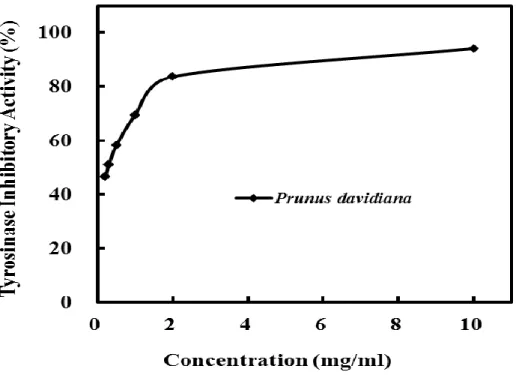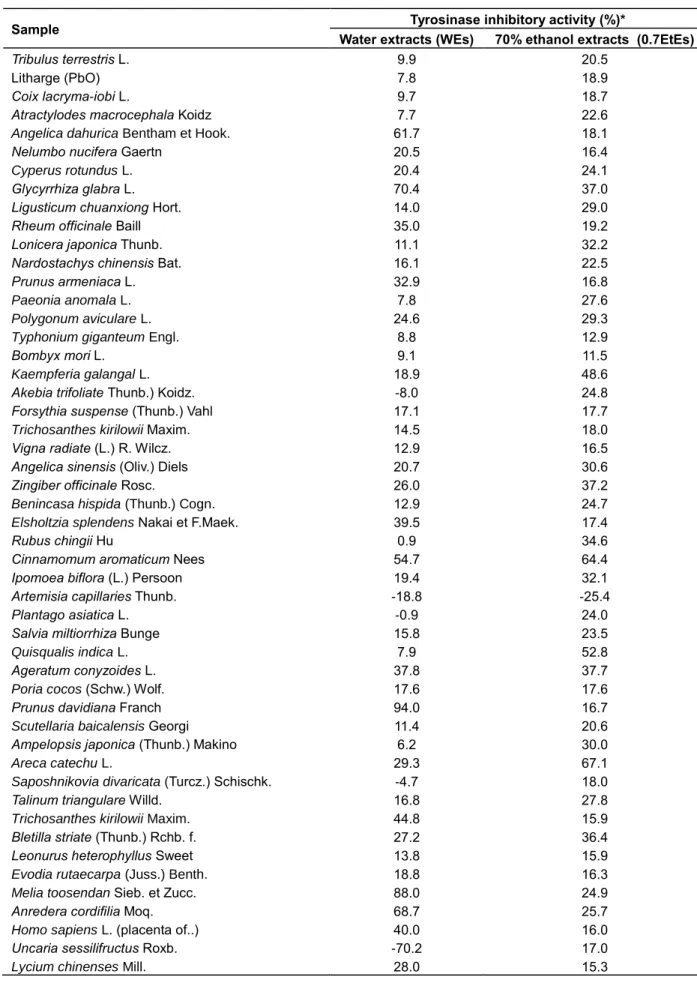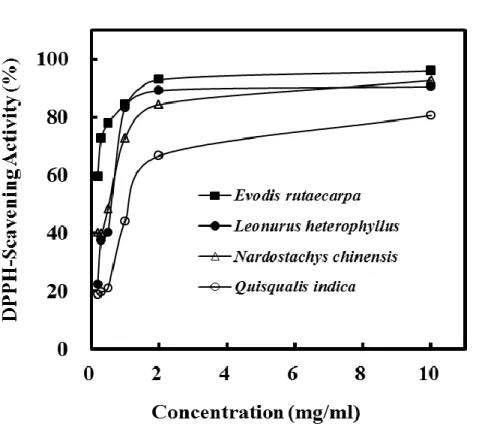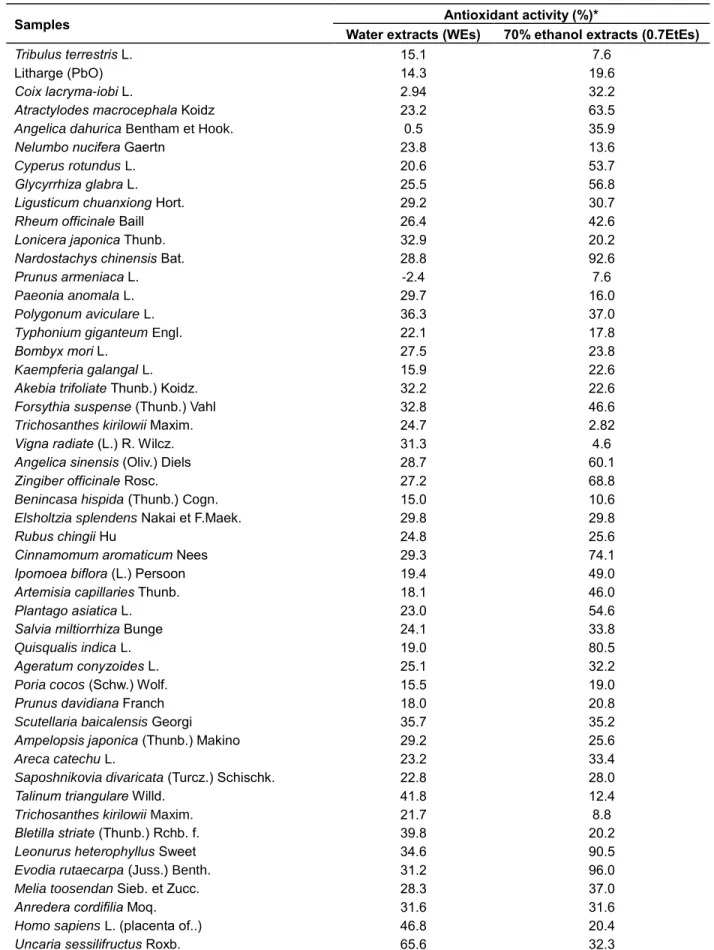DOI:10.5897/JMPR2015.5953 Article Number: B2F187E56777 ISSN 1996-0875
Copyright © 2015
Author(s) retain the copyright of this article http://www.academicjournals.org/JMPR
Journal of Medicinal Plants Research
Full Length Research Paper
Effect of extracts of traditional Chinese medicines on
anti-tyrosinase and antioxidant activities
Ting-Fang Hsieh
1*, Yaw-Nan Chang
2and Bing-Lan Liu
31Floriculture Research Center, Taiwan Agricultural Research Institute, Council of Agriculture, Yunlin 646, Taiwan. 2Department of Biotechnology, National Formosa University, Yunlin 632, Taiwan.
3Department of Applied Chemistry, Chaoyang University of Technoloyg, Wufeng, Taichung 413, Taiwan. Received 19 September, 2015; Accepted 10 December, 2015
Fifty important cosmetic skin-whiting traditional Chinese medicines (TCMs) were investigated for their anti-tyrosinase and antioxidant (or DPPH-free-radical-scavenging) activities. The water and 70% ethanol extracts (WEs and 0.7EtEs, respectively) of TCMs were tested for tyrosinase inhibitory activities and DPPH-free-radical-scavenging activities. The 10 mg/ml WEs of 6 TCMs, Angelica dahurica, Anredera
cordifilia Moq., Cinnamomum aromaticum, Glycyrrhiza glabra, Melia toosendan, and Prunus davidiana,
presented over 50% inhibitory effect (referred to as the positive control of 0.5 mg/ml vitamin C) in tyrosinase activity, while Prunus davidiana showed the best anti-tyrosinase activity (94.0%). Only 3 TCMs of 0.7EtEs, Cinnamomum aromaticum, Quisqualis indica, Areca catechu, exhibited over 50% anti-tyrosinase activity. Among the TCMs screened, the 10mg/ml 0.7EtEs of Evodis rutaecarpa, Leonurus
heterophyllus, Nardostachys chinensis, and Quisqualis indica, had strong
DPPH-free-radical-scavenging effects or antioxidant activities (96.0, 90.5, 92.6 and 80.6%, respectively), while all the WEs of TCMs, except Uncaria sessilifructus Roxb, showed low antioxidant activities (65.6%). The anti-tyrosinase and antioxidant activities of these two TCM extracts may be due to direct linkage to the contents of their active compounds.
Key words: Traditional Chinese medicines, inhibition, anti-tyrosinase, antioxidant, free radical scavenging.
INTRODUCTION
The search for natural active compounds from natural herbal medicines or traditional Chinese medicines (TCMs) provides an interesting, largely unexplored area for development of new skin-care cosmetics (Kiken and Cohen, 2002; Kadekaro et al., 2003; Wang et al., 2006), such as natural whitening agents like melanin biosynthesis or tyrosinase inhibitors, which are able to modulate the metabolism of pigmentation for color of
human skin and play a crucial protective role in skin whiteness, whereas antioxidants active in the oxidative stress of skin aging cells may support skin health. Melanin, which is biosynthesized by melanocyte cells in the basal layer of the epidermis (Hearing, 2005; Chen et al., 2015), may be overproduced with chronic sun exposure, melasma, or other hyperpigmentation diseases (Briganti et al., 2003). Therefore, whitening agents *Corresponding author. E-mail: tfhsieh@tari.gov.tw. Tel: +886-5-5828150.
Author(s) agree that this article remain permanently open access under the terms of the Creative Commons Attribution License 4.0 International License
reduce melanin overproduction like hyperpigmentation of darkened age spots, whereas pigmenting agents such as melanins are designed to increase pigmentation for sun protection. However, the inhibition of melanin biosynthesis has already been described by avoiding ultraviolet (UV) exposure, inhibiting melanocyte metabolism and proliferation (Seiberg et al., 2000; Chang, 2012), inhibiting tyrosinase activity, or removing melanin with corneal ablation (Wang et al., 2006).
Tyrosinase is known to be the key enzyme in the anabolism of melanin biosynthesis in melanocytes (Sturm et al., 2001; Parvez et al., 2007; Chang, 2012), catalyzing the initial two steps of this pathway, including hydroxylation of tyrosine (one of monophenolic compounds) to L-dopa (L-3,4-dihydroxyphenylalane; one of o-diphenols) and oxidation of L-dopa to o-dopaquinone (one of o-quinones). These o-quinones are then transformed into melanin in a series of non-enzymatic reactions (Prota, 1988). Therefore, tyrosinase inhibitors are important constituents of cosmetics and skin-lightening agents (An et al., 2005), and tyrosinase becomes the key target enzyme for screening and discovery of new inhibitory compounds. This is why a constant search for tyrosinase inhibitors obtained by extraction from natural plants or TCMs is underway in the hope of preventing the occurrence of these melanin overproductions or hyperpigmentation disorders (No et al., 1999). The highly reactive intermediate produced by dopa oxidation, and the reactive oxygen species (ROS) and other free radicals induced by oxidative stress in skin cells or by UV radiation exposure have been presented to be inappropriately processed in enhancing melanin biosynthesis, damaging DNA, probably inducing proliferation of melanocytes (Yamakoshi et al., 2003; Yasui and Sakurai, 2003). The free radicals or ROS scavengers such as antioxidants may be known to reduce hyperpigmentation (Ma et al., 2001). Although the plant-derived antioxidants scavenge free-radicals, it is assumed that their nature and concentration vary among different kinds of plants. However, 1,1-diphenyl-2-picrylhydrazyl (DPPH) is a stable radical and the DPPH free radical-scavenging assay is a simple and widely popular method for screening free radical-scavenging ability of compounds or antioxidant activity of plant extracts. In this study, the biological evaluations of water and 70% ethanol extracts (WEs and 0.7EtEs, respectively) of 50 TCMs were investigated for the inhibition of tyrosinase activity and the antioxidation of DPPH-free-radical-scavenging activity. The comparison of the anti-tyrosinase and antioxidant activities of these two TCM extracts was also studied.
MATERIALS AND METHODS Reagents and TCM materials
Tyrosine, L-dopa, mushroom tyropsinase (Prod. No. T7755), DPPH were purchased from Sigma (St. Louis, MO). Other chemicals were
of the highest grade commercially available. TCMs were purchased from local medicinal markets in Taichung County, Taiwan.
Preparation of TCM extracts
Dried TCMs were pulverized in a grinder and 10 g of the pulverized TCM powders were extracted with 100 ml of distilled water (WEs) or 70% ethanol solution (0.7EtEs) at 28°C for 24 h. Extraction was carried out under shaking (100 rpm). The WEs was filtered with 0.22 μm membrane and the filtrate was stored at 4°C until use. The 0.7EtEs filtrate was completely dried at 50°C and then re-dissolved with distilled water. The samples of 0.7EtEs were obtained after filtration with 0.22 μm membrane.
Assay for tyrosinase inhibitory activity
Tyrosinase activity was determined by spectrophotometry (Masamoto et al., 1980; Bernard and Berthon, 2000) with slight modification. Briefly, 1.0 ml of the test sample (10 mg/ml extract) with or without WEs or 0.7EtEs, 1.0 ml of 20 mM phosphate buffer (pH 6.2) and 0.25 ml of 10 mM tyrosine were mixed at 37°C for 10 min. Subsequently, 25 ml of mushroom tyrosinase (200 U/ml) was added into the mixture. After incubation at 37°C for 25 min, the absorbance was measured at 475 nm (OD475) using a SHIMADZU
UV-Visible spectrophotometer (Model UV-1201). The same procedure was applied with 0.5 mg/ml of vitamin C (as the positive controls for comparison with those of the WEs). To test the concentration required for 50% inhibition (IC50) values of TCMs on
anti-tyrosinase activity, 1.0 ml of the test samples with different concentrations was performed as described above. For 0.7EtEs, the inhibition percentage of tyrosinase activity was calculated as follows:
Inhibition (%) = [1 - (OD475 with test sample) / (OD475 without test
sample)] × 100
For WEs, the tyrosinase inhibitory activity was calculated with the following formula:
Inhibition (%) = [(% inhibition of test sample) / (% inhibition of vitamin C)] × 100
Assay for DPPH-free-radical-scavenging activity
The sample (either 50 μl of 10 mg/ml test sample or 50 μl of serial dilution concentrations of test samples mixed with 950 μl of 25 mM DPPH in methanol) test preparation underwent reaction in the dark at room temperature for 30 min. Fifty microliters of methanol was used as a positive control. The same procedure was applied with 0.2 mg/ml of vitamin C for comparison with those of the WEs. The decrease in absorbance at 517 nm (A517) induced by the samples
was compared to that of the positive controls (Yamaguchi et al., 1998). The effect percentage of DPPH-free-radical-scavenging activity was calculated as follows:
Scavenging effect (%) = [1 - (A517 of test sample) / (A517 of control)]
× 100%
Determining IC50 of TCM extracts
To calculate the concentration required for 50% inhibition (IC50)
value of TCM extracts, the data of anti-tyrosinase or antioxidant activities (yi) obtained from a series of concentration (xi) of TCM extracts were put in the software of ICEstimator (ICEstimator Version 2.1, http://www.antimalarial-icestimator.net/index.htm) and
Figure 1. Effect of concentrations of Prunus davidiana water-extracts (WEs) on tyrosinase inhibitory activity.
a nonlinear regression (yi=a+bxi+cxi2) was carried out to get the IC50 value. Herein, yi is the inhibition activity in relative
concentration of TCMs (Le Nagard et al., 2010).
Statistical analysis
Data were subjected to the analysis of variance (ANOVA) using the software package (SAS 8.1, Cary, NC, USA). In the case of significant treatment effects, a comparison of means was performed by means of the least significant difference (LSD) test at a significance level of 5% (p = 0.05).
RESULTS
Tyrosinase inhibitory activity
The summarized results of mushroom tyrosinase inhibition of the 10 mg/ml extracts (WEs and 0.7EtEs) of 50 TCMs are shown in Table 1. Over 50% of anti-tyrosinase activity were observed in the WEs of 6 TCMs,
Angelica dahurica, Anredera cordifilia Moq.,
Cinnamomum aromaticum, Glycyrrhiza glabra, Melia toosendan and Prunus davidiana (61.7, 68.7, 54.7, 70.4,
88.0 and 94.0%, respectively) referred to as that of vitamin C (0.5 mg/ml). Yet, only P. davidiana WEs exhibited the highest inhibition of tyrosinase with value over 90%. Figure 1 shows the dose-response curve for the inhibitory effect of tyrosinase activity of the P.
davidiana WEs with different concentration (mg/ml). The
tyrosinase inhibitory activity of P. davidiana WEs at a
dilution concentration of 2 mg/ml was still about 84%. Linear dose-dependent behavior on tyrosinase activity inhibitions (ranged from 51 to 84%) affected by P.
davidiana WEs was found to be between the dilution
concentration 0.3 and 2 mg/ml (Figure 1). The tyrosinase inhibitory effect was increased with increasing dilution concentration of P. davidiana WEs. The IC50 of P.
davidiana on tyrosinase activity inhibitions was 0.24
mg/ml. Among the 50 tested 0.7EtEs, only 3 TCM extracts, Areca catechu, C. aromaticum and Q. indica, presented good anti-tyrosinase activities with values at 50-70%, as shown in Table 1.
DPPH-free-radical-scavenging activity
The effect results of DPPH-free-radical-scavenging activity of the 50 TCM extracts were summarized in Table 2. The higher scavenging activity implies the higher DPPH-free-radical-scavenging ability or antioxidant activity. Of 50 TCM WEs, only Uncaria sessilifructus Roxb had a good antioxidant activity (65.6%). In contrast, 4 TCM 0.7EtEs, Evodis rutaecarpa, Leonurus heterophyllus, Nardostachys chinensis and Quisqualis indica, exhibited strong antioxidant activities (96.0, 90.5,
92.6 and 80.6%, respectively) (Table 2). Similar to the tyrosinase inhibitory activity of the P. davidiana WEs, these 0.7EtEs exhibited dose-response curves for scavenging effect or antioxidant activity as shown in Figure 2. The antioxidant activity was increased with
Table 1. Effect of water and 70% ethanol extracts of traditional Chinese medicines on tyrosinase inhibitory activity.
Sample Tyrosinase inhibitory activity (%)*
Water extracts (WEs) 70% ethanol extracts (0.7EtEs)
Tribulus terrestris L. 9.9 20.5
Litharge (PbO) 7.8 18.9
Coix lacryma-iobi L. 9.7 18.7
Atractylodes macrocephala Koidz 7.7 22.6
Angelica dahurica Bentham et Hook. 61.7 18.1
Nelumbo nucifera Gaertn 20.5 16.4
Cyperus rotundus L. 20.4 24.1
Glycyrrhiza glabra L. 70.4 37.0
Ligusticum chuanxiong Hort. 14.0 29.0
Rheum officinale Baill 35.0 19.2
Lonicera japonica Thunb. 11.1 32.2
Nardostachys chinensis Bat. 16.1 22.5
Prunus armeniaca L. 32.9 16.8
Paeonia anomala L. 7.8 27.6
Polygonum aviculare L. 24.6 29.3
Typhonium giganteum Engl. 8.8 12.9
Bombyx mori L. 9.1 11.5
Kaempferia galangal L. 18.9 48.6
Akebia trifoliate Thunb.) Koidz. -8.0 24.8
Forsythia suspense (Thunb.) Vahl 17.1 17.7
Trichosanthes kirilowii Maxim. 14.5 18.0
Vigna radiate (L.) R. Wilcz. 12.9 16.5
Angelica sinensis (Oliv.) Diels 20.7 30.6
Zingiber officinale Rosc. 26.0 37.2
Benincasa hispida (Thunb.) Cogn. 12.9 24.7
Elsholtzia splendens Nakai et F.Maek. 39.5 17.4
Rubus chingii Hu 0.9 34.6
Cinnamomum aromaticum Nees 54.7 64.4
Ipomoea biflora (L.) Persoon 19.4 32.1
Artemisia capillaries Thunb. -18.8 -25.4
Plantago asiatica L. -0.9 24.0
Salvia miltiorrhiza Bunge 15.8 23.5
Quisqualis indica L. 7.9 52.8
Ageratum conyzoides L. 37.8 37.7
Poria cocos (Schw.) Wolf. 17.6 17.6
Prunus davidiana Franch 94.0 16.7
Scutellaria baicalensis Georgi 11.4 20.6
Ampelopsis japonica (Thunb.) Makino 6.2 30.0
Areca catechu L. 29.3 67.1
Saposhnikovia divaricata (Turcz.) Schischk. -4.7 18.0
Talinum triangulare Willd. 16.8 27.8
Trichosanthes kirilowii Maxim. 44.8 15.9
Bletilla striate (Thunb.) Rchb. f. 27.2 36.4
Leonurus heterophyllus Sweet 13.8 15.9
Evodia rutaecarpa (Juss.) Benth. 18.8 16.3
Melia toosendan Sieb. et Zucc. 88.0 24.9
Anredera cordifilia Moq. 68.7 25.7
Homo sapiens L. (placenta of..) 40.0 16.0
Uncaria sessilifructus Roxb. -70.2 17.0
Table 1. Cont’d
Vitamin C (L-ascorbic acid) (0.5mg/mL) 100.0 ---
LSD0.05 6.2 5.7
* Measurements were performed in triplicate.
Figure 2. Effect of concentrations of 70% ethanol extracts (0.7EtEs) of 4 TCMs,
Evodis rutaecarpa, Leonurus heterophyllus, Nardostachys chinensis, and Quisqualis indica, on DPPH-free-radical-scavenging activity (antioxidant activity).
increasing dilution concentration of these 4 0.7EtEs. The IC50 of 4 0.7TtEs, E. rutaecarpa, L, heterophyllus, N.
chinensis and Q. indica, on antioxidant activity were 0.12,
0.41, 0.34, 0.79 mg/ml, respectively. The 7 other 0.7EtEs,
Angelica sinensis, Atractylodes macrocephpala Koidz, C. aromaticum, Cyperus rotundus, G. glabra, Zingiber officinale, Plantago asiatica, also present good antioxidant activities with values between 50 and 80% (Table 2).
DISCUSSION
In this study, WEs and 0.7EtEs of 50 TCMs were measured for the performance of anti-tyrosinase and antioxidant activities. The result indicated that 10 mg/ml aqueous extract of P. davidiana showed the best anti-tyrosinase activity (94.0%) similar to 0.5 mg/ml of vitamin C. Concentration required for 50% inhibition (IC50) values
of P. davidiana on anti-tyrosinase activity was 0.24 mg/ml. In terms of antioxidant activity, 0.7EtEs of E.
rutaecarpa and L. heterophyllus were the best two TCMs,
even though at 1.0 mg/mL concentration, they could still maintain more than 80% of the free radical scavenging ability. IC50 of two TCMs were 0.12 and 0.41 mg/ml, respectively.
In terms of Chinese herbal whitening, effect of Bletilla
striate, Ampelopsis japonica, A. dahurica, Atractylodes macrocephala and Typhonium giganteum widely used in
cosmetic products were considered. However, the present study found that the tyrosinase inhibition activities of these TCMs were lower than 50% whether in WEs or 0.7EtEs. This result is inconsistent with other studies (Chun et al., 2003; Ye et al., 2010). In addition, the tyrosinase inhibitory effect of Ligusticum chuanxiong has been reported in different polarization results. For example, Deng et al. (2007) reported the ethanol extract of L. chuanxiong has stronger inhibitory effect on
Table 2. Effect of water and 70% ethanol extracts of traditional Chinese medicines on DPPH-free-radical-scavenging activity (antioxidant activity).
Samples Antioxidant activity (%)*
Water extracts (WEs) 70% ethanol extracts (0.7EtEs)
Tribulus terrestris L. 15.1 7.6
Litharge (PbO) 14.3 19.6
Coix lacryma-iobi L. 2.94 32.2
Atractylodes macrocephala Koidz 23.2 63.5
Angelica dahurica Bentham et Hook. 0.5 35.9
Nelumbo nucifera Gaertn 23.8 13.6
Cyperus rotundus L. 20.6 53.7
Glycyrrhiza glabra L. 25.5 56.8
Ligusticum chuanxiong Hort. 29.2 30.7
Rheum officinale Baill 26.4 42.6
Lonicera japonica Thunb. 32.9 20.2
Nardostachys chinensis Bat. 28.8 92.6
Prunus armeniaca L. -2.4 7.6
Paeonia anomala L. 29.7 16.0
Polygonum aviculare L. 36.3 37.0
Typhonium giganteum Engl. 22.1 17.8
Bombyx mori L. 27.5 23.8
Kaempferia galangal L. 15.9 22.6
Akebia trifoliate Thunb.) Koidz. 32.2 22.6
Forsythia suspense (Thunb.) Vahl 32.8 46.6
Trichosanthes kirilowii Maxim. 24.7 2.82
Vigna radiate (L.) R. Wilcz. 31.3 4.6
Angelica sinensis (Oliv.) Diels 28.7 60.1
Zingiber officinale Rosc. 27.2 68.8
Benincasa hispida (Thunb.) Cogn. 15.0 10.6
Elsholtzia splendens Nakai et F.Maek. 29.8 29.8
Rubus chingii Hu 24.8 25.6
Cinnamomum aromaticum Nees 29.3 74.1
Ipomoea biflora (L.) Persoon 19.4 49.0
Artemisia capillaries Thunb. 18.1 46.0
Plantago asiatica L. 23.0 54.6
Salvia miltiorrhiza Bunge 24.1 33.8
Quisqualis indica L. 19.0 80.5
Ageratum conyzoides L. 25.1 32.2
Poria cocos (Schw.) Wolf. 15.5 19.0
Prunus davidiana Franch 18.0 20.8
Scutellaria baicalensis Georgi 35.7 35.2
Ampelopsis japonica (Thunb.) Makino 29.2 25.6
Areca catechu L. 23.2 33.4
Saposhnikovia divaricata (Turcz.) Schischk. 22.8 28.0
Talinum triangulare Willd. 41.8 12.4
Trichosanthes kirilowii Maxim. 21.7 8.8
Bletilla striate (Thunb.) Rchb. f. 39.8 20.2
Leonurus heterophyllus Sweet 34.6 90.5
Evodia rutaecarpa (Juss.) Benth. 31.2 96.0
Melia toosendan Sieb. et Zucc. 28.3 37.0
Anredera cordifilia Moq. 31.6 31.6
Homo sapiens L. (placenta of..) 46.8 20.4
Table 2. Cont’d.
Lycium chinenses Mill. 33.3 40.3
Vitamin C (L-ascorbic acid) (0.2 mg/mL) 98.6 ---
LSD0.05 6.8 5.6
* Measurements were performed in triplicate.
tyrosinase activity (Deng et al., 2007), but Chen et al. (2008) reported that ethanol extract of L. chuanxiong enhances the activity of tyrosinase. In this study, tyrosinase inhibition rate of L. chuanxiong was much less than 50%. Wang et al. (2002) reported that the 50% ethanol extract of Prunus persica (L.) Batsch did not show a good tyrosinase inhibitory effect. In contrast, the WEs of P. davidiana showed the best anti-tyrosinase activity with the inhibition rate of 94% in the present study. Thus, the differences in tyrosinase inhibitory activity for TCM WEs and 0.7EtEs may be due to the various active components of different TCM sources and their polarities and other properties related to the extract methods and the solvent constituents (Ko et al., 2002; Wang et al., 2002).
To determine the antioxidant activity, 50 TCM extracts were screened for their DPPH-free-radical-scavenging activity. Of 11 TCM, 0.7EtEs showed good antioxidant activities with values more than 50%. Among them, E.
rutaecarpa, L. heterophyllus, N. chinensis and Q. indica,
exhibited strong antioxidant activities with values more than 80%. E. rutaecarpa is commonly used as an analgesic, antiemetic, anti-inflammatory and astringent drug in TCMs (Tang and Eisenbrand, 1992). The total alkaloids obtained from the fruits of E. rutaecarpa was found and the total antioxidant capacity and inhibitory lipid peroxidation are superior to synthetic antioxidant 2, 6-di-ter-butyl-4-methylphenol (BHT), but scavenging activity on DPPH radical is lower than that of BHT at the same condition (Tan et al., 2011). Wang et al. (2006) examined 25 TCMs that might be useful for antioxidant agents and pointed out that L. heterophyllus can effectively inhibit formation of •OH in a concentration-dependent manner. The IC50 value of N. chinensis essential oil to scavenge DPPH radical was 637.47 μg/ml (Wang et al., 2010). Anu Kiruthika and Sornaraj (2014) reported the methanolic crude extracts of Q. indica flower possess significant antioxidant activity which might be due to the presence of alkaloids, tannins, flavonoids and saponin. However, all the WEs of TCMs, except U.
sessilifructus showed a poor antioxidant activity as
compared to all the 0.7EtEs. This finding maybe due to the fact that 70% ethanol solution is an active solvent constitute for extraction of these good or strong TCM antioxidants. The result suggested that these 4 TCM 0.7EtEs may contain constituents with strong proton-donating abilities (Sawai and Moon, 2000). In addition, to the authors’ knowledge, there is no report regarding the
antioxidant activity of U. sessilifructus extracts.
Conclusion
In the present study, there is no doubt that the extract methods and the solvent constituents play important roles in extraction of natural active compounds of 50 selected TCMs, described for anti-tyrosinase activity and antioxidant activity. The P. davidiana WEs and the E.
rutaecarpa 0.7EtEs were investigated for potential
effectiveness as skin-whitening agents and in maintaining healthy skin, respectively. In the future, the isolation and structural elucidation of the active bio-guided isolated compounds of these 2 TCMs will likely have considerable value as cosmetics additives and be useful for cosmetic applications and products.
Conflict of Interests
The authors have not declared any conflict of interests.
ACKNOWLEDGEMENTS
This research was partly supported by grants awarded to Dr. T.-F. Hsieh from the Ministry of Science and Technology, Taiwan. The authors thank Ms. W. H. Chung and L. Y. Lee for technical assistance.
REFERENCES
An BJ, Kwak JH, Park JM, Lee JY, Park TS, Lee JT, Son JH, Jo C, Byun MW (2005). Inhibition of enzyme activities and the antiwrinkle effect of polyphenol isolated from the persimmon leaf (Diospyros kaki
folium) on human skin. Dermatol. Surg. 31:848-854.
Anu Kiruthika K, Sornaraj R (2014). Assessment of antioxidant property of Quisqualis indica. Asian J. Pharm. Sci. Technol. 4(1):34-36. Bernard P, Berthon JY (2000). Resveratrol: an original mechanism on
tyrosinase inhibition. Int. J. Cosmetic Sci. 22:219-226.
Briganti S, Camera E, Picardo M (2003) Chemical and instrumental approaches to treat hyperpigmentation. Pigment Cell Res. 16:101-110.
Chang TS (2012). Natural melanogenesis inhibitors acting through the down-regulation of tyrosinase activity. Materials 5:1661-1685. Chen H, Li QY, Zhu KP (2008). Effect of Rehmannia glutinosa and
Ligusticum chuanxiong Hort. extracts on tyrosinase. Acta Acad. Med.
17(5):378-380.
Chen WC, Tseng TS, Hsiao NW, Lin YL, Wen ZH, Tsai CC, Tsai KC (2015). Discovery of highly potent tyrosinase inhibitor, T1, with significant anti-melanogenesis ability by zebrafish in vivo assay and
computational molecular modeling. Sci. Rep. 5:7995.
Chun HJ, Lee JH, Choi EY, Baek SH (2003). Inhibitory effects of ethanol extract of Atractylodis Rhizoma on melanogenesis in B16/F10 melanoma cells. Orient. Pharm. Exp. Med. 3(2):80-83. Deng XQ, Gong SZ, Jae XY (2007). Study on tyrosinase inhibitory
activity of Ligusticum chuanxiong extract. Zhong Yao Cai 30(4):469-471.
Hearing VJ (2005). Biogenesis of pigment granules: a sensitive way to regulate melanocyte function. J. Dermatol. Sci. 37:3-14.
Kadekaro AL, Kanto H, Kavanagh R, Abdel-Malek ZA (2003). Significance of the melanocortin 1 receptor in regulating human melanocyte pigmentation, proliferation, and survival. Ann. N. Y. Acad. Sci. 994:359-365.
Kiken DA, Cohen DE (2002). Contact dermatitis to botanical extracts. Am. J. Contact Dermat. 13:148-152.
Ko HC, Chen KT, Chou CJ, Chen CF (2002). Determination of dehydroevodiamine, evodiamine, rutaecarpine and synephrine in
Evodia genus plants from Taiwan and Mainland China. J. Chin. Med.
13(3):151-158.
Le Nagard H, Vincent C, Mentré F, Le Bras J (2010). Online analysis of in vitro resistance to antimalarial drugs through nonlinear regression. Comput. Methods Programs Biomed. 104(1):10-8.
Ma W, Wlaschek M, Tantcheva-Poor I, Schneider LA, Naderi L, Razi-Wolf Z, Schuller J, Scharffetter-Kochanek K (2001). Chronological ageing and photoageing of the fibroblasts and the dermal connective tissue. Clin. Exp. Dermatol. 26:592-599.
Masamoto Y, Iida S, Kubo M (1980). Inhibitory effect of Chinese crude drugs on tyrosinase. Planta Med. 40:361-365.
No JK, Soung DY, Kim YJ, Shim KH, Jun YS, Rhee SH, Yokozawa T, Chung HY (1999). Inhibition of tyrosinase by green tea components. Life Sci. 65:241-246.
Parvez S, Kang M, Chung HS, Bae H (2007). Naturally occurring tyrosinase inhibitors: mechanism and applications in skin health, cosmetics and agriculture industries. Phytother. Res. 21:805-816. Prota G (1988). Progress in the chemistry of melanins and related
metabolites. Med. Res. Rev. 8:525-555.
Sawai Y, Moon JH (2000). NMR analytical approach to clarify the molecular mechanisms of the antioxidative and radical-scavenging activities of antioxidants in tea using 1,1-diphenyl-2-picrylhydrazyl. J. Agric. Food Chem. 48:6247-6253.
Seiberg M, Paine C, Sharlow E, Andrade-Gordon P, Costanzo M, Eisinger M, Shapiro SS (2000). Inhibition of melanosome transfer results in skin lightening. J. Invest. Dermatol. 115:162-167.
Sturm RA, Teasdale RD, Box NF (2001). Human pigmentation genes: identification, structure and consequences of polymorphic variation. Gene 277(1-2):49-62.
Tan MX, Liu YC, Luo XJ, Li DQ (2011). Studies on the Antioxidant Activities of Total Alkaloids from the Fruits of Evodia rutaecarpa (Juss.) Benth. Adv. Mat. Res. 396-398:52-55.
Tang W, Eisenbrand G (1992). Evodia rutaecarpa (Juss) Benth. In: Tang W, Eisenbrand G (eds.), Chinese Drugs of Plant Origin, Springer-Verlag, Berlin. pp. 509-514.
Wang J, Zhao J, Liu H, Zhou L, Liu Z, Wang J, Jianguo Han J, Yu Z, Yang F (2010). Chemical analysis and biological activity of the essential oils of two valerianaceous species from China:
Nardostachys chinensis and Valeriana officinalis. Molecules
15:6411-6422.
Wang JH, Lei F, Cui JR (2002). Inhibitory effect of 20 Chinese crude drugs on tyrosinase. Chung Kuo Yao Hsueh Tsa Chih 35(1):232-234. Wang KH, Lin RD, Hsu FL, Huang YH, Chang HC, Huang CY, Lee MH
(2006). Cosmetic applications of selected traditional Chinese herbal medicines. J. Ethnopharmacol. 106:353-359.
Yamaguchi T, Takamura H, Matoba T, Terao J (1998). HPLC method for evaluation of the free radical-scavenging activity of foods by using 1,1-diphenyl-2-picrylhydrazyl. Biosci. Biotechnol. Biochem. 62:1201-1204.
Yamakoshi J, Otsuka F, Sano A, Tokutake S, Saito M, Kikuchi M, Kubota Y (2003). Lightening effect on ultraviolet-induced pigmentation of guinea pig skin by oral administration of a proanthocyanidin-rich extract from grape seeds. Pigment Cell Res. 16:629-638.
Yasui H, Sakurai H (2003). Age-dependent generation of reactive oxygen species in the skin of live hairless rats exposed to UVA light. Exp. Dermatol. 12:655-661.
Ye Y, Chou GX, Mu DD, Wang H, Chu JH, Leung AKM, Fong WF, Yu ZL (2010). Screening of Chinese herbal medicines for antityrosinase activity in a cell free system and B16 cells. J. Ethnopharmacol. 129(3):387-390.




